In May 2012 we are undertaking a three-week long collaborative research project off the island of Hawai‘i. This will be our 11th year of working off the “big island”, and the first of three field projects this summer in Hawai‘i (we’ll be working off Kaua‘i in June and early July and back to the big island in August). The research team includes Russ Andrews of the University of Alaska Fairbanks/Alaska SeaLife Center, Stacy DeRuiter of Woods Hole Oceanographic Institution (WHOI), Dan McSweeney of the Wild Whale Research Foundation, and Jessica Aschettino, Greg Schorr, Daniel Webster and Robin Baird of Cascadia. Like most of our field projects we have a number of research goals. Our primary funding for this project comes from grants from the Office of Naval Research (ONR), through WHOI, and the National Oceanographic Partnership Program (NOPP), through the Alaska SeaLife Center. The NOPP grant (primarily funded by ONR) focuses on follow up of previously satellite tagged individuals and using a Forward Looking Infra Red (FLIR) camera to examine circulation in the dorsal fin of tagged individuals, while the WHOI-ONR grant is to study the acoustic behavior of melon-headed whales and false killer whales using suction-cup attached DTags (Digital acoustic tags). In addition to those primary goals, we will be deploying satellite tags on a number of species to examine movements and habitat use, obtaining identification photos of a number of species of toothed whales and dolphins to assess abundance and social organization, as well as collecting biopsy samples for genetic and toxicology studies.
End of project update

Short-finned pilot whale spyhopping, May 24, 2012. Photo (c) Robin Baird
May 24th was our last day on the water. Over the 20 day trip we covered almost 2,400 km of trackline, had 81 encounters with 13 species of odontocetes, took over 43,000 photos or video recordings, deployed 2 DTags and 5 satellite tags, obtained acoustic recordings and FLIR images from a number of groups, collected 12 squid specimens and 13 biopsy samples, and recovered and redeployed the HARP. Overall a very productive trip. Our next field project in Hawai’i will be in just over 2 weeks off the island of Kaua’i – check our field projects update page in a couple of weeks for information on that trip.

Our tracklines for the trip with May 24th highlighted.

Movements of the five satellite tagged individuals (of four different species) over the last 10 days. Only high quality locations are shown.
May 23, 2012 update

Striped dolphins, May 23, 2012. Photo (c) Russ Andrews. Today we encountered our 13th species of odontocete for the trip, a group of striped dolphins. This species typically avoids boats in Hawaiian waters and is usually found offshore – our group was in about 3,000 m of water. We also encountered a group of four Blainville’s beaked whales, two dwarf sperm whales, and a group of spotted dolphins, as well as collecting our fifth squid for the trip.
May 22, 2012 update
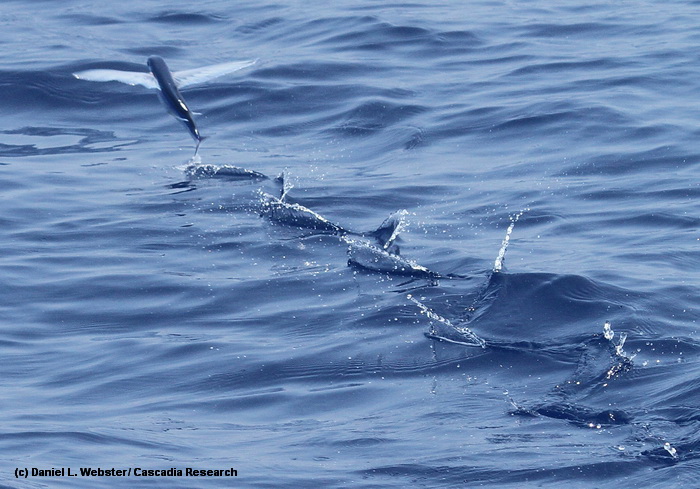
Flying fish taking off, May 22, 2012. Photo (c) Daniel Webster. We tally the number of flying fish we see each day, as an index of productivity of the area. Today we saw over 150 flying fish, our largest number this trip (although we had only one odontocete sighting all day, a group of pilot whales).

A Hawaiian Petrel, May 22, 2012. Photo (c) Daniel Webster.
May 21, 2012 update

Short-finned pilot whale juvenile rolling at surface, showing the pectoral flipper, May 21, 2012. Photo (c) Daniel Webster
May 20, 2012 update

A mother and calf Cuvier’s beaked whale, May 20, 2012. Photo (c) Robin Baird. The adult female was first documented off the island in 2009 – this individual is quite unusual, missing most of it’s rostrum (see photos from April 23, 2009).

A dwarf sperm whale, May 20, 2012. Photo (c) Jessica Aschettino. We also encountered a very distinctive dwarf sperm whale – this individual has a hole through the fin, presumably caused by a bite from a cookie-cutter shark. We also collected our 10th squid for the trip, and encountered a large group of bottlenose dolphins.
May 19, 2012 update

A pair of pygmy killer whales, May 19, 2012. Photo (c) Russ Andrews. Today we encountered our 12th species of odontocete for the trip, a group of four pygmy killer whales. There is a resident population of pygmy killer whales off the island, and at least two of the individuals we encountered are in our catalog, both first seen off the island in 2006, and documented five times since off Kona, most recently in 2010. We also collected another squid, encountered a group of three Blainville’s beaked whales, two groups of pilot whales, and recovered the ECG tag deployed yesterday.
May 18, 2012 update

Short-finned pilot whale with a suction-cup attached DTag, May 18, 2012. Photo (c) Robin Baird. We encountered two groups of pilot whales today, and deployed one DTag, which stayed on for ~3.5 hours during which the whale made three deep foraging dives (to >750 m), and also deployed an ECG (Electrocardiogram) tag developed by Russ Andrews, to study diving physiology. The ECG tag was still on the whale when we left and we are hoping to recover it tomorrow.

One of two squid we collected today, the 8th squid we’ve collected this trip. Photo (c) Daniel Webster.
May 17, 2012 update

Rough-toothed dolphin leaping, May 17, 2012. Photo (c) Stacy DeRuiter. Today we had only our second encounter with rough-toothed dolphins this trip – the dolphins were feeding, and thus quite erratic, so we weren’t able to get many photos.

Short-finned pilot whale and BURP (Biological Underwater Recording Package), May 17, 2012. Photo (c) Jay Barlow. This trip we have been obtaining recordings of pilot whales for the Southwest Fisheries Science Center using a remote recording system (the “BURP”) that we deploy in front of a group of whales and recover after the whales have passed by.

Dwarf sperm whale porpoising, May 17, 2012. Photo (c) Jessica Aschettino. We also had two encounters with dwarf sperm whales today, now our third-most frequently encountered species this trip. During one of the encounters a juvenile whale porpoised completely clear of the water, quite an unusual sight for dwarf sperm whales!

Flying fish, May 17, 2012. Photo (c) Jessica Aschettino. We also tally the number of flying fish we see each day, to use as a potential indicator of overall productivity of the area within and between trips.
May 16, 2012 update

Pantropical spotted dolphin mother and calf, May 16, 2012. Photo (c) Robin Baird. Another good day on the water, with encounters with four different species of odontocetes.

Cuvier’s beaked whale, May 16, 2012. Photo (c) Daniel Webster. This photo is not cropped, an adult male Cuvier’s beaked whale logging at the surface. Old adults often appear very white in color, and adult males typically have numerous linear scars from fighting with other adult males.

Today we collected our fifth squid for the trip, photo (c) Daniel Webster. These squid most likely end up at the surface as discarded prey of deep-diving odontocetes such as beaked whales, pilot whales, or sperm whales.
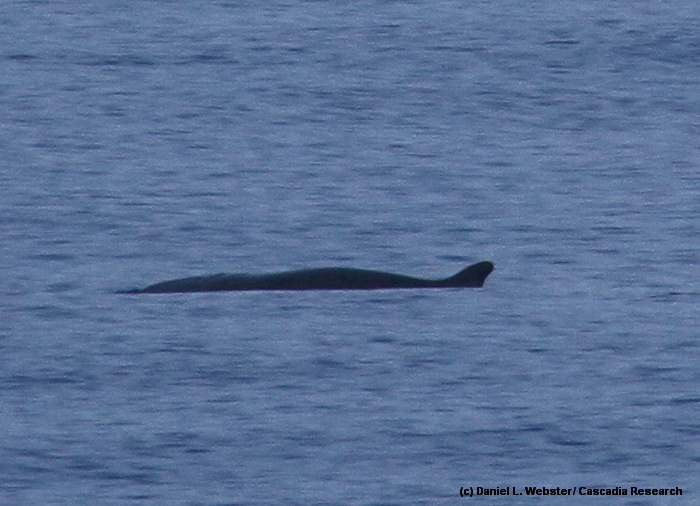
A probable pygmy sperm whale off Kona, May 16, 2012. Photo (c) Daniel Webster. We regularly see dwarf sperm whales off the island but rarely see pygmy sperm whales, and the two species are very difficult to tell apart (there are differences in the size, shape and positioning of the dorsal fin, as well as relative head size and total body size, all of which make us think this is a pygmy sperm whale).
May 15, 2012 update

Two dwarf sperm whales off Kona, May 15, 2012. Photo (c) Stacy DeRuiter. Today we had two encounters with dwarf sperm whales, a group of three (including the two above) and a group of seven. There is a resident population of dwarf sperm whales off the island – the well-marked individual above is HIKs020 in our photo-ID catalog, an adult female first documented off the island in 2004 and seen in 2006, 2008, 2009, and most recently in November 2011.

A juvenile Blainville’s beaked whale, May 15, 2012. Photo (c) Daniel Webster. We encountered a pair of juvenile Blainville’s beaked whales today, and were able to photo-identify both and collected one biopsy sample for genetic analyses. The coloration on the head of this individual probably comes from diatoms growing on the skin, and we are able to classify this individual as a juvenile based on the relatively few scars from cookie-cutter shark bites.

A juvenile Blainville’s beaked whale, May 15, 2012, with a fresh bite wound from a cookie-cutter shark. Photo (c) Daniel Webster
May 14, 2012 update

Bottlenose dolphin with a very distinctive dorsal fin off Kohala, May 14, 2012. Photo (c) Robin Baird

Bottlenose dolphin with satellite tag at base of fin, May 14, 2012. Today we deployed our first satellite tag on a bottlenose dolphin off Hawai‘i Island, and the second we have deployed in Hawai‘i (the first we deployed during our Kaua‘i project last summer). From photo-identification we know individual bottlenose dolphins are resident to the west side of the island but most of our sightings are concentrated in the shallow water west of Kohala, so knowledge of movements is limited. This tag will give the first detailed movement data for this species off the island.

A map showing the first day of movements of the satellite tagged bottlenose dolphin off the north end of the island.
Underwater video of the melon-headed whales from May 13
May 13, 2012 update

Fraser’s dolphins off Kona, May 13, 2012. Photo (c) Jessica Aschettino. Today was our ninth day on the water for the trip and we encountered our 9th and 10th species of odontocetes. The most unusual sighting was a group of about 75 Fraser’s dolphins, only our second sighting of this species in 13 years of field work in Hawai‘i – out last sighting was on April 30, 2008, also off the Kona coast.

Fraser’s dolphin, May 13, 2012. Photo (c) Daniel Webster. Fraser’s dolphins have only been documented in Hawaiian waters on a few occasions, primarily because they are typically found far from shore and often avoid boats.

Fraser’s dolphin, May 13, 2012. Photo (c) Daniel Webster. Like our first sighting of this species in 2008, this group was on the periphery of a group of melon-headed whales.
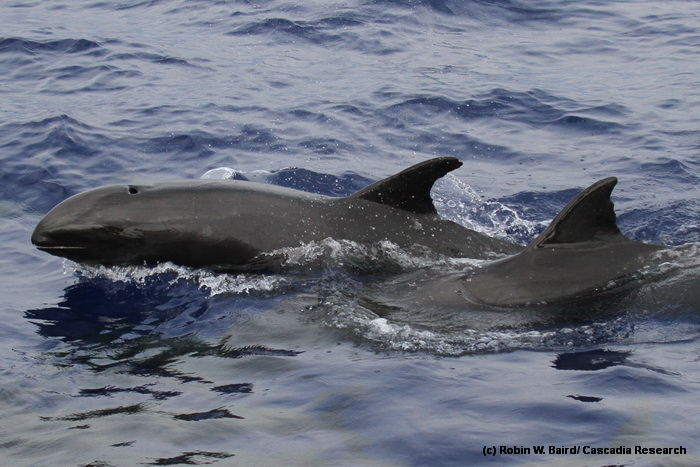
Melon-headed whales, May 13, 2012. Photo (c) Robin Baird. The group of ~280 melon-headed whales are part of the Main Hawaiian Islands population, which moves among the islands and into offshore waters (there are two populations of this species in Hawai‘i – see our web page on this species for more information.

Melon-headed whale with a suction-cup attached digital acoustic tag (“DTag”), May 13, 2012. Photo (c) Robin Baird. During this encounter we photographed over 200 individuals for individual identification, deployed a suction-cup attached DTag to record underwater behavior and acoustics, and deployed one satellite tag to track the group.
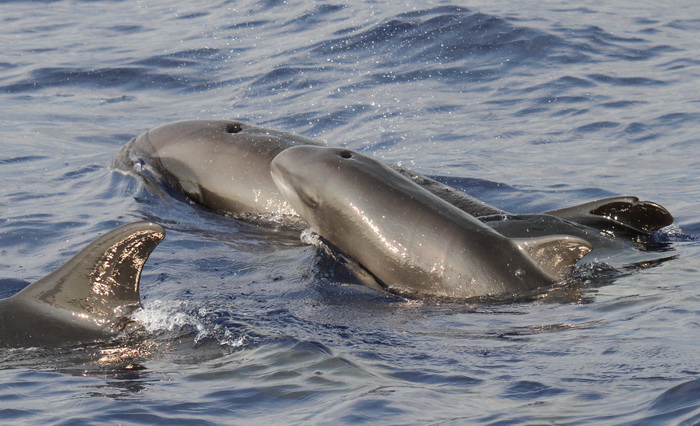
Adult female and a newborn melon-headed whale, May 13, 2012. Photo (c) Robin Baird. Two fetal folds, faint vertical creases on the body formed in utero, are still visible
May 11th and 12th, 2012 updates

Bottlenose dolphin mother and calf, May 12, 2012. Photo (c) Daniel Webster.

The weather has not been quite as cooperative the last two days, but we have been able to cover a 100 kilometer stretch of the Kona coast – today we did the loop to the north, and yesterday we did the loop to the south. During the last two days we had sightings of three species, pantropical spotted dolphins, bottlenose dolphins, and the lone spinner dolphin in with the group of spotted dolphins. We collected one squid sample, two biopsy samples for genetics and toxicology studies, and photos of many of the individuals present for individual identification.

Pantropical spotted dolphin mother and calf, May 11, 2012. Photo (c) Daniel Webster.
May 10th, 2012 update

Our 8th species of odontocete for the trip, a group of bottlenose dolphins, May 10, 2012. Photo (c) Daniel Webster. We were able to photo-identify all the individuals in the group.
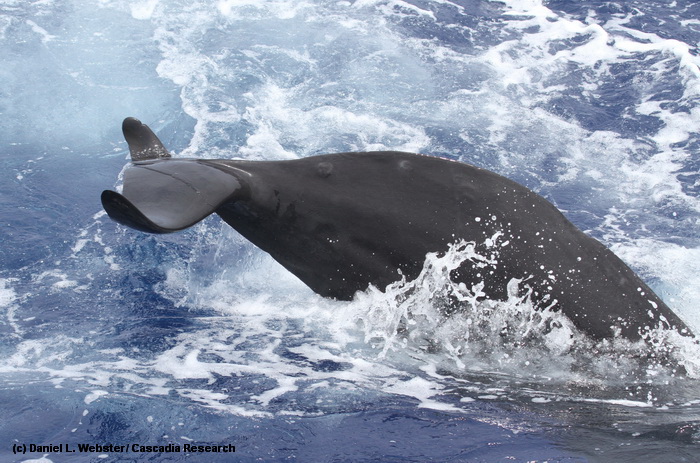
A pilot whale tail-lobbing, May 10, 2012. Photo (c) Daniel Webster. We also encountered two groups of short-finned pilot whales, were able to photo-identify all the individuals present and obtained FLIR images from several individuals, including two individuals we had satellite-tagged during our field project in October/November 2011.

We also collected a large fecal sample from the pilot whales, which will be used for diet studies. Photo (c) Robin Baird.

A map showing movements of two satellite-tagged Blainville’s beaked whales over a 4-day period. Although the two individuals were more than 40 km apart when the second individual was tagged, two days after tagging they had joined up and appear to be in the same area, surfacing at the same time. Only high quality ARGOS locations are shown, we have many more locations from these two individuals but need to process the data to eliminate unrealistic locations before any sort of analysis.
May 9th, 2012 update

A FLIR (Forward Looking Infra Red) image of short-finned pilot whales, photo (c) Greg Schorr. One of the goals of this project is to obtain FLIR images of pilot whales and other species to assess circulation in the dorsal fins of tagged and untagged individuals. This photo shows the heat signature from two pilot whales from today, one with tooth rakes on the leading edge of the dorsal fin. A photo of these two individuals is below.

A photograph of the two individuals in the FLIR image above, May 9, 2012. Photo (c) Jessica Aschettino

A short-finned pilot whale being measured using a laser photo-grammetry system, May 9, 2012. The two green dots are visible on the body below the front half of the dorsal fin (on either side of an hold cookie-cutter shark scar). Photo (c) Jessica Aschettino. We are using a pair of green-dot lasers 15 cm apart to measure the dorsal fins of pilot whales and other species to help determine age and sex class.
May 8th, 2012 update

A sub-adult male Blainville’s beaked whale, May 8, 2012. Photo (c) Jessica Aschettino. Today we encountered a group of four Blainville’s beaked whales and were able to get identification photos of three of the individuals, as well as deploy a satellite tag on one individual (an adult female). This individual is identifable as a sub-adult male based on the arch of the lower jaw.
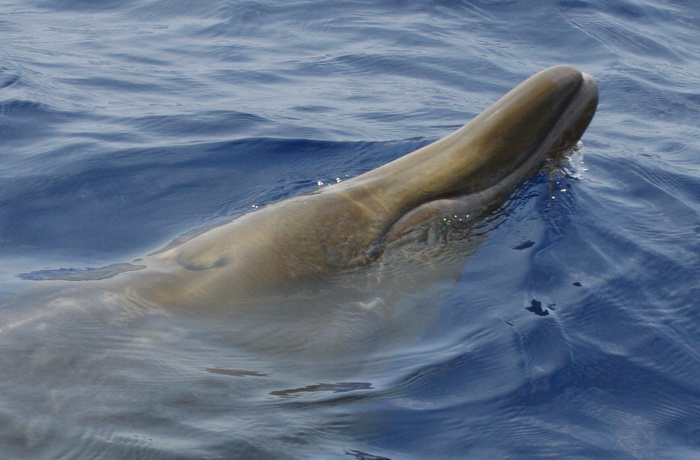
An adult female Blainville’s beaked whale, May 8, 2012. Photo (c) Jessica Aschettino. Compare the arch of the lower jaw of this individual with the sub-adult male above.

An adult female Blainville’s beaked whale with a deformed upper jaw, May 8, 2012. Photo (c) Robin Baird. This individual, HIMd025 in our catalog, was first documented off Kona in 1991 by Dan McSweeney, and has been seen in nine different years since.
May 7th, 2012 update

Three Blainville’s beaked whales, May 7, 2012. Photo (c) Robin W. Baird. A good day on the water – our most productive encounter was with a group of three Blainville’s beaked whales. We were able to deploy a satellite tag on one individual (an adult male, in the bottom right of the photo), we obtained two biopsy samples (of the tagged whale and one of the adult females), and got good identification photos of all three individuals – from a quick look at the photos Sabre Mahaffy was able to match one of the individuals, an adult female, to our catalog. This individual, HIMd061 in our catalog, was first seen off the island in 1997, and was last seen in May 2009.

Close-up of the head of an adult male Blainville’s beaked whale, May 7, 2012. Photo (c) Stacy DeRuiter. This photo shows two clusters of stalked barnaclesattached to the two erupted teeth of this adult male (the red colored clusters in the upper right of the photo), as well as the linear scars (light-colored lines) typically found on adult male Blainville’s beaked whales.

Dwarf sperm whale, May 7, 2012. Photo (c) Robin W. Baird. We also had our second sighting of dwarf sperm whales in three days, a group of seven individuals, of which we were able to photo-identify six individuals.

Dwarf sperm whale, May 7, 2012. Photo (c) Robin W. Baird. This individual has two fairly fresh bite wounds from cookie-cutter sharks (the two oval wounds), as well as an older healed wound on the head, probably from an attack by a large shark.

An oceanic white-tip shark next to our boat (this photo, taken with a 100 mm lens, is not cropped). Photo (c) Jessica Aschettino. We also had several encounters with short-finned pilot whales and were able to photo-identify most of the individuals, obtain FLIR images, and document oceanic white-tip sharks that were associated with the group. When possible we are trying to obtain dorsal fin photos of oceanic white-tip sharks, to identify individuals using the white patterning, to see if sharks are remaining associated with the same groups of pilot whales over time.

Cuvier’s beaked whale, May 7, 2012. Photo (c) Daniel Webster. We also encountered our 7th species of odontocete for the trip, a lone Cuvier’s beaked whale that was with a group of pilot whales, and were able to get good identification photos to compare to our catalog. This individual is likely an adult, based on the number of oval scars caused by cookie-cutter sharks, and is probably a female, based on the lack of erupted teeth and linear scars seen in adult males. For more information on this species (and on Blainville’s beaked whales) see our page on beaked whales.

A Hawaiian petrel, May 7, 2012. Photo (c) Daniel Webster. We also record and, when possible, photograph all rare species of seabirds on our trips. For more photos and information on seabirds in Hawai‘i see our seabird page.
May 6th, 2012 update

Today was our second day on the water for this trip and we encountered our fifth species of odontocete, four rough-toothed dolphins. Photo (c) Daniel L. Webster. The rough-toothed dolphins appeared in the middle of a group of short-finned pilot whales and remained with the group of pilot whale for the duration of our encounter. We were able to get good identification photos of all four individuals and will compare them to our catalog. There is a small and apparently resident population of rough-toothed dolphins off the island of Hawai‘i – for more information on this species see our rough-toothed dolphin page.

Short-finned pilot whale spyhopping, showing the lighter grey post-orbital blazes, May 6, 2012. Photo (c) Jessica M. Aschettino. During the day we had five separate encounters with pilot whales, with an estimated 94 individuals – we think we photo-identified 93 of the 94 whales, and were able to obtain FLIR images of about 20 different individuals. We also witnessed two of the groups meeting, with a lot of socializing, including spyhopping by multiple individuals.

Juvenile short-finned pilot whale, with injury above the eye, May 6, 2012. Photo (c) Robin W. Baird. The injury above the eye of this individual appears very similar to abrasions caused by persistent remora damage on other species.
May 5th, 2012 update

Recording a FLIR image of a short-finned pilot whale, May 5, 2012. Photo (c) Robin W. Baird.
A good first day on the water. We covered over 130 kilometers of trackline, with five sightings of four different species of odontocetes. We encountered two groups of short-finned pilot whales, were able to photo-identify all the individuals present, and obtained FLIR images of at least seven different individuals (including at least one that we had satellite-tagged last year).

Two short-finned pilot whales, May 5, 2012. Photo (c) Dan J. McSweeney
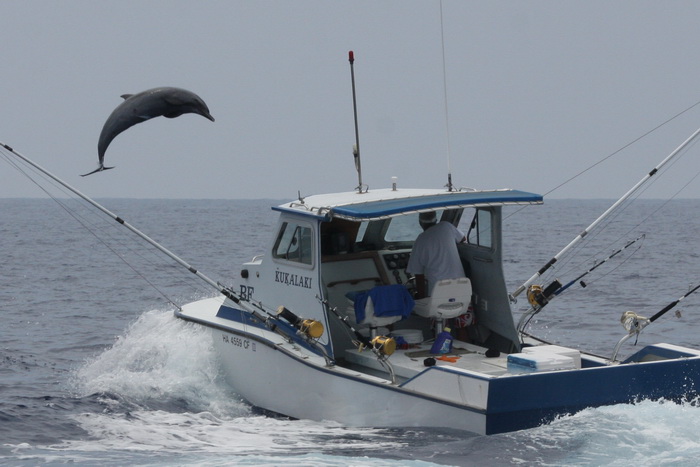
Pantropical spotted dolphin leaping in front of boat, May 5, 2012. Photo (c) Jessica M. Aschettino. Despite appearances, this dolphin was well in front of the boat when leaping! We also encountered a large group of pantropical spotted dolphins, and were able to get identification photos of many of the individuals present.

Within the group there was a single spinner dolphin, the same spinner dolphin we encountered offshore with spotted dolphins several times last year. Photo (c) Daniel L. Webster.
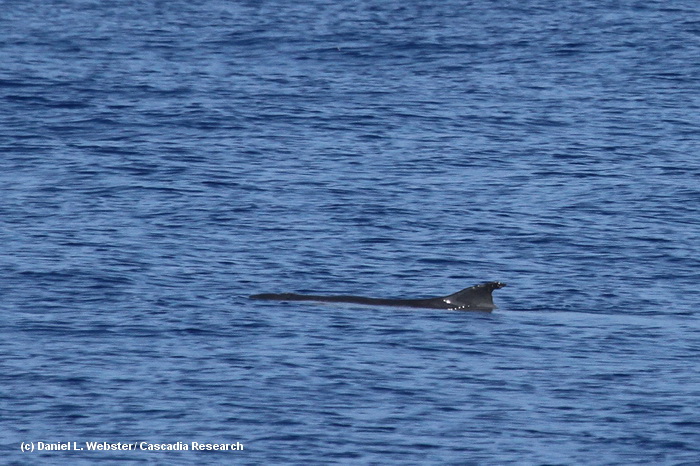
Although not our closest, or perhaps most “exciting” encounter of the day, one of the most interesting was a sighting of a lone dwarf sperm whale. We were able to get good photos of this individual, and although well marked this individual has not been previously photographed in our study. Photo (c) Daniel L. Webster.
Sign up to our Facebook page if you want to receive notices of when information is posted and updates on other Cascadia projects.